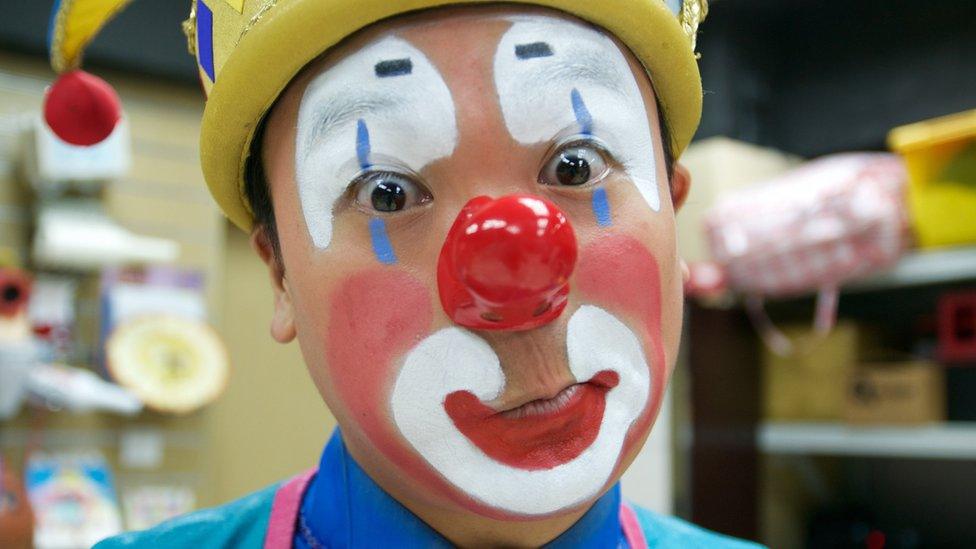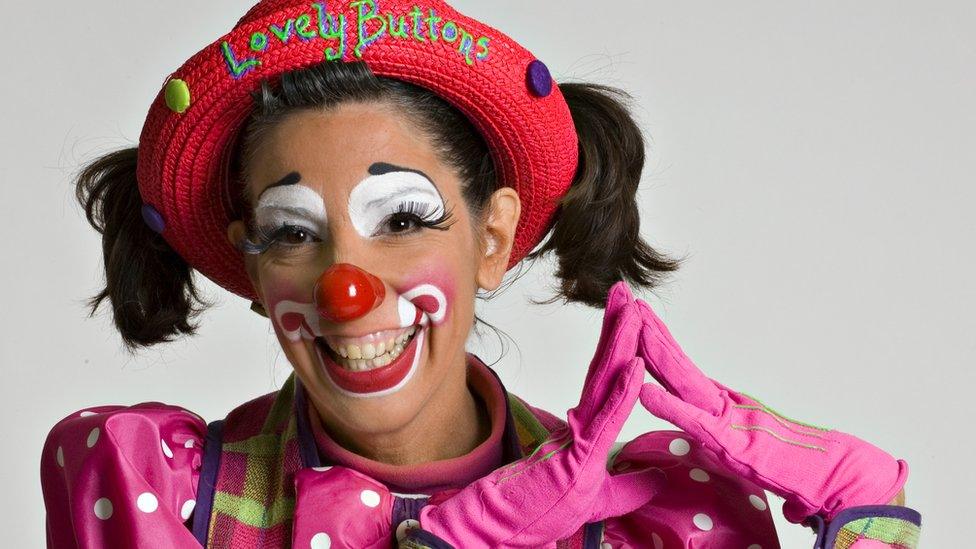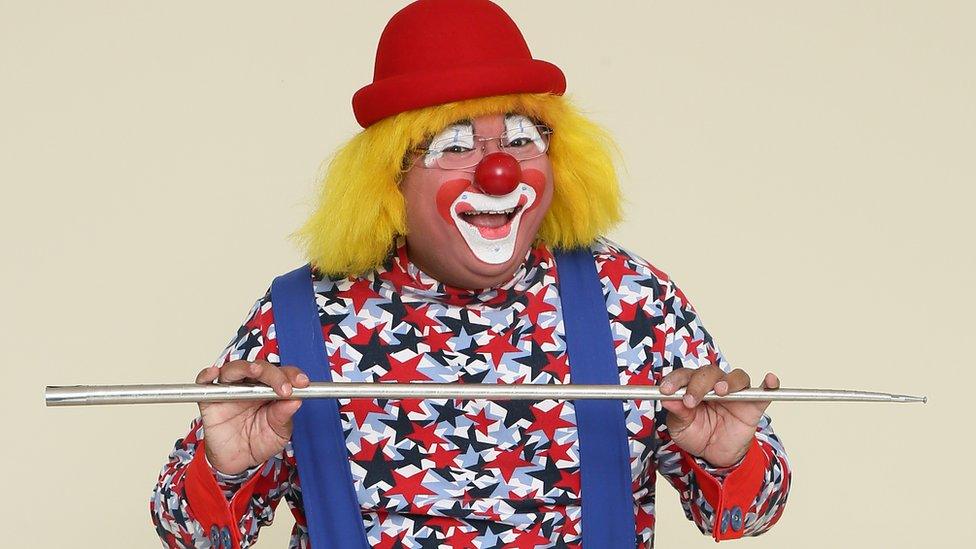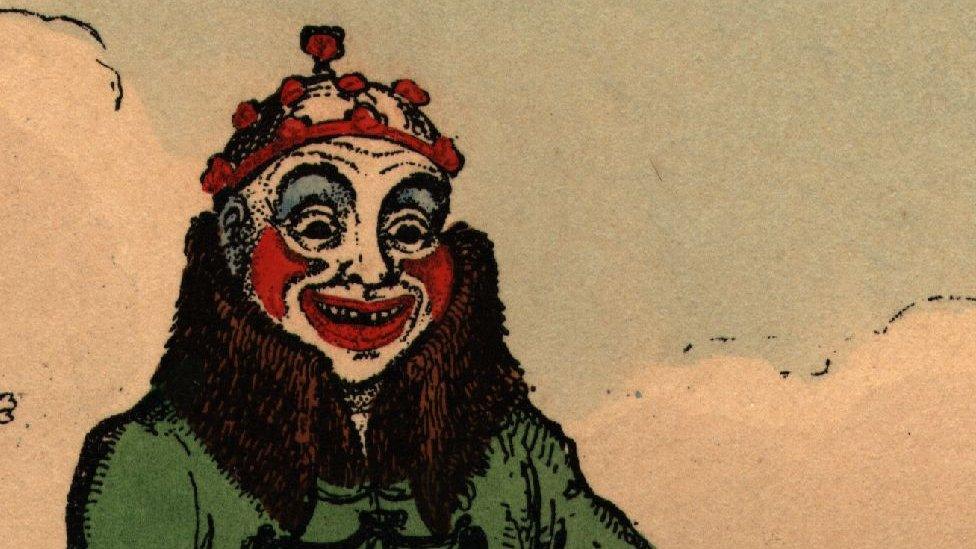Mixed fortunes in the world of clowning
- Published

Ken Ken says he was "sad" about the creepy clowns craze
Dressed in a patchwork of bright colours, Ken Ken the Clown fashions a flower out of yellow and pink balloons, and smiles widely.
One of the first professional clowns in Hong Kong, the 35-year-old says that for the past 15 years he has been pursuing what he calls a "positive" career that "makes people happy".
Often fully booked, Ken Ken can earn as much as HK$550,000 ($71,000; £57,000) per year. And such is the continuing popularity of hiring a clown in Hong Kong for kids' parties that he is far from alone.
While he cut a lone figure back in 2001, Ken Ken says that today there are as many as 50 other professional clowns in the special administrative region, and that the number is rising fast.
In fact, such is the current demand for clowns in Hong Kong that employment agencies are organising classes to train up people.

Kenneth Ng, aka "Ken Ken the Clown" (right), trains other people to become clowns
One such agency is Grace Training and Development Centre. Enya Hui, one of its employment officers, says that clowning is now a "viable career path".
The current popularity of clowns in Hong Kong is in marked contrast to the woes faced by the entertainers in the US and Europe, who this year have had to endure the so-called "creepy clown craze".
This unlikely phenomenon on both sides of the Atlantic saw people dressing up as scary clowns to terrify children and adults alike. It led to some schools going as far as even banning children from talking about the craze.

This year's creepy clown craze has not helped the industry
Against such a backdrop it is not surprising that clowns in the US and Europe have recently found bookings harder to come by - mums and dads are not likely to hire a clown for their child's birthday party if their little one is now scared of them.
What is less well known is that the clowning industry has been in long-term decline in its established markets, with the World Clown Association saying that membership numbers have fallen by almost a third over the past 10 years, from about 3,500 to 2,500.
So why are clowns struggling in the US and Europe, but booming in Hong Kong and other Asian countries, such as India?

A clown is nothing without a quality pair of oversized shoes
When not performing as a clown Ken Ken's real name is Kenneth Ng. Describing his clown persona as "a happy and hyperactive five-year-old", Mr Ng says that it took him 10 years to develop the character.
While he always plays the same role, he says that "every performance is different".
With up to 100 performances a year, plus income from training other clowns at a weekly class, Mr Ng earns enough money from being a clown for it to be his only profession.
This is in marked contrast to most clowns in the US and Europe, who usually need another job to supplement their income.

American clown Julie Varholdt says she has to work hard to secure business
Julie Varholdt, 52, a fourth-generation clown from Phoenix, Arizona, says that a typical clown in the US earns just $14,000 (£11,400) a year. This is five times less than Mr Ng, so one reason for the growing popularity of clowning in Hong Kong but decline in the US is inevitably financial.
Ms Varholdt says she is able to make enough money from being a clown - called Lovely Buttons - not to require a second source of income, but that it's not an easy ride.
"It takes a lot of work to be a full-time entertainer, you have to market yourself constantly, and work to secure your gigs," she says.

Martin D'Souza is a well-known clown in Mumbai
In the Indian city of Mumbai, Martin "Flubber" D'Souza is another full-time clown. He says he feels "empowered" when he becomes his character.
Despite his family's objections the 47-year-old became a professional clown after completing two university degrees, one in physics and another in management.
He now earns a good living both performing himself, and running a clown hire business that has 80 other performers, all university students, on its books.
Mr D'Souza says more young Indians want to become clowns because "the youth of today are looking for an alternative form of education and employment".
He adds: "They are bored with conventional nine-to-five jobs, and clowning has become respectable."

Clown facts

The first clowns are believed to have been entertainers in Ancient Egypt
The first modern clown was a man called Joseph Grimaldi (depicted above), who in the UK in the early 19th Century was the first to paint his face white and add a red smile
Every year in London, on the first Sunday in February, clowns gather for a church service to honour and remember Joseph Grimaldi
International Clown Week takes place every year in October. The US also has a National Clown Week every August
Some people have always been scared of clowns. The phenomenon is called coulrophobia
The real name of Krusty the Clown from The Simpsons is Herschel Shmoikel Pinchas Yerucham Krustofsky

Mr D'Souza also thanks the popularity of Indian films.
"In India many youngsters are taking up dancing and performing thanks to Bollywood. I really believe there's a hunger for the stage and recognition because everyone wants to stand out.
"Today parents aren't shy to say that their son or daughter is a clown."

Becoming a clown requires buying a lot of clothing and props
Another difference between clowning in Asia and that in the US and Europe is a significant age gap.
"You don't find a lot of young clowns in the West," says Mr D'Souza. The average age of clowns in Asia is between 25 and 30, whereas in the West, the average age is over 50.
"In the West they don't think of clowning as a lucrative career... but in Asia people are really looking at it as an alternative to an office or factory job."
As discussed, the problem for most clowns in the West is that it doesn't pay a great deal. At least outside of working for the likes of circus groups Ringling Bros and Cirque de Soleil, and Disney.
To attract more clowns in the US and Europe there will need to be an increase in popularity, which would raise demand and therefore earnings. This may be sometime away.
However Kenny Ahern, co-owner of Wisconsin-based Clown Camp, the world's largest clown school, says he is not worried.
"Clowning has not lasted throughout time without reason, and I don't expect it to be going anywhere," he says.